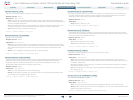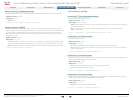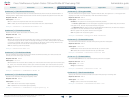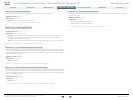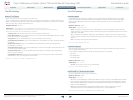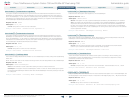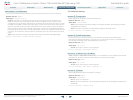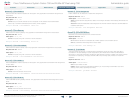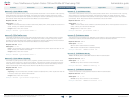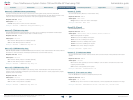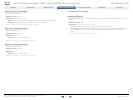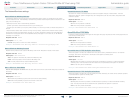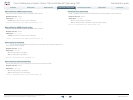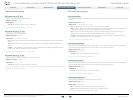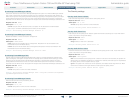
46
Cisco TelePresence System Codec C90 and Prole 65” Dual using C90 Administrator guide
D14635.05 Prole C90 and Codec C90 Administrator Guide TC4.1, February 2011.
Copyright © 2010-2011 Cisco Systems, Inc. All rights reserved.
www.cisco.com
Network [1..1] QoS Diserv Audio
The Diserv Audio denes which priority Audio packets should have in an IP network. Enter a priority,
which ranges from 0 to 63 for the packets. The higher the number, the higher the priority. These
priorities might be overridden when packets are leaving the network controlled by the local network
administrator. NOTE: Requires the Network QoS Mode to be set to Diserv.
Requires user role: ADMIN
Value space: <0..63>
Audio: A recommended value is Diserv Code Point (DSCP) AF41, which equals the value 34. If in
doubt, contact your network administrator.
Range: Select a value from 0 to 63.
Example: Network 1 QoS Diffserv Audio: 0
Network [1..1] QoS Diserv Data
The Diserv Data denes which priority Data packets should have in an IP network. Enter a priority,
which ranges from 0 to 63 for the packets. The higher the number, the higher the priority. These
priorities might be overridden when packets are leaving the network controlled by the local network
administrator. NOTE: Requires the Network QoS Mode to be set to Diserv.
Requires user role: ADMIN
Value space: <0..63>
Data: A recommended value is Diserv Code Point (DSCP) AF23, which equals the value 22. If in
doubt, contact your network administrator.
Range: Select a value from 0 to 63.
Example: Network 1 QoS Diffserv Data: 0
Network [1..1] QoS Diserv Signalling
The Diserv Signalling denes which priority Signalling packets should have in an IP network. Enter
a priority, which ranges from 0 to 63 for the packets. The higher the number, the higher the priority.
These priorities might be overridden when packets are leaving the network controlled by the local
network administrator. NOTE: Requires the Network QoS Mode to be set to Diserv.
Requires user role: ADMIN
Value space: <0..63>
Signalling: A recommended value is Diserv Code Point (DSCP) AF31, which equals the value 26.
If in doubt, contact your network administrator.
Range: Select a value from 0 to 63.
Example: Network 1 QoS Diffserv Signalling: 0
Network [1..1] QoS Diserv Video
The Diserv Video denes which priority Video packets should have in an IP network. Enter a priority,
which ranges from 0 to 63 for the packets. The higher the number, the higher the priority. These
priorities might be overridden when packets are leaving the network controlled by the local network
administrator. NOTE: Requires the Network QoS Mode to be set to Diserv.
Requires user role: ADMIN
Value space: <0..63>
Video: A recommended value is Diserv Code Point (DSCP) AF41, which equals the value 34. If in
doubt, contact your network administrator.
Range: Select a value from 0 to 63.
Example: Network 1 QoS Diffserv Video: 0
Network [1..1] IEEE8021X Mode
The system can be connected to an IEEE 802.1X LAN network, with a port-based network access
control that is used to provide authenticated network access for Ethernet networks.
Requires user role: ADMIN
Value space: <On/Off>
On: The 802.1X authentication is enabled.
O: The 802.1X authentication is disabled (default).
Example: Network 1 IEEE8021X Mode: Off
Network [1..1] IEEE8021X Identity
The 802.1X Identity is the user name needed for 802.1X authentication.
Requires user role: ADMIN
Value space: <S: 0, 64>
Format: String with a maximum of 64 characters.
Example: Network 1 IEEE8021X Identity: ""
Network [1..1] IEEE8021X Password
The 802.1X Password is the password needed for 802.1X authentication.
Requires user role: ADMIN
Value space: <S: 0, 32>
Format: String with a maximum of 32 characters.
Example: Network 1 IEEE8021X Password: "***"
Contents
Contact us
Introduction
Advanced conguration
Password protection
Web interface
Appendices
Advanced conguration



